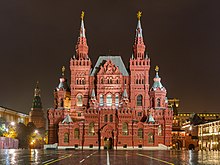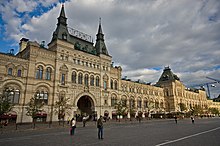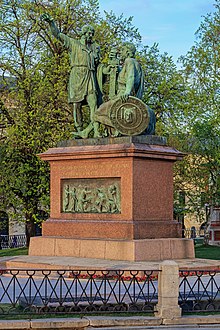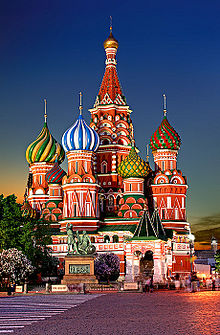Red Square
It is the city's most prominent landmark, with famous buildings such as Saint Basil's Cathedral, Lenin's Mausoleum and the GUM department store.
In the northeast, the square is bounded by the GUM department store building and the old district of Kitay-gorod, in the northwest by the State Historical Museum and the Resurrection Gate and in the southeast by Saint Basil's Cathedral.
Tverskaya Street begins to the northwest of the square behind the building of the State Historical Museum, and to the southeast is the so-called Basilius slope, which leads to the Moskva River, which goes down and over a bridge to the Zamoskvorechye District.
Three square gates existed on this side of the wall, which in the 17th century, were known as: Konstantino-Eleninsky, Spassky, Nikolsky (owing their names to the icons of Constantine and Helen, as well as Christ the Savior and St. Nicholas which hung over them).
In 1697 and 1699, gates on both sides of Voskresensky Bridge were rebuilt into large stone buildings: the Mint and Zemsky prikaz (department in charge of urban and police matters).
In the 1930s, Kazan Cathedral and Iverskaya Chapel with the Resurrection Gates were demolished to make room for heavy military vehicles driving through the square (both were later rebuilt after the fall of the Soviet Union).
There were plans to demolish Moscow's most recognized building, Saint Basil's Cathedral, as well to make way for a larger Red Square, as well as the State Historical Museum.
Linkin Park, The Prodigy, t.A.T.u., Shakira, Scorpions, Paul McCartney, Roger Waters, Red Hot Chili Peppers, and other celebrities performed there.
Between the two portals on the north side of the gate, the chapel of the icon of the Mother of God of Iviron, originally built in 1781, was rebuilt at the same time.
This was built in 1697 by decree of Peter the Great and since then has housed a production facility for silver coins for almost a quarter of a century before the money issuing system of the tsarist Empire was essentially relocated to Saint Petersburg.
According to a legend, it was precisely this icon of the Russian People's army, led by the national heroes Kuzma Minin and Dmitri Pozharsky, who defeated the Military of the Polish–Lithuanian Commonwealth in 1612.
In the 17th and 18th centuries, the Kazan Cathedral on Red Square was one of the most important Moscow places of worship and was the scene of solemn cross processions led by the patriarch and the tsar, especially on the anniversary of the victory over the Polish-Lithuanian Commonwealth.
The GUM department store, situated at the eastern side of the square, occupies the entire section between Nikolskaya and Ilyinka streets.
In the 1990s, the store was privatised and thoroughly renovated, and today, it presents itself to the locals and tourists as a noble shopping centre characterised by boutiques in the upper price ranges.
[9] The building at the easternmost point of the square, on the corner of Ilyinka Street, stands exactly where the Middle Trading Rows stood in the 17th century.
This massive expanse of assorted market stalls and self-made wooden huts was for the first time replaced at the end of the 18th century, by a building complex specially built for trade, whose authorship is attributed to the Italian builder Giacomo Quarenghi.
The building's architect was Roman Klein, who also designed numerous other well-known Moscow structures in the late 19th century, including the Pushkin Museum.
At the beginning of 2007, four inner structures of the former trading rows were demolished while plans were made to reconstruct the entire building true to the original to house an exclusive hotel.
[10] The Lobnoye Mesto (Russian: Лобное место) is a round, grandstand-like structure made of white stone in the southeastern part of the square, in front of Saint Basil's Cathedral.
The monument to the two Russian national heroes Kuzma Minin and Prince Dmitri Poszharsky, erected between 1812 and 1818, stands directly in front of Saint Basil's Cathedral.
Just like the Kazan Cathedral donated by the latter at the time in the northern part of the square, this monument also commemorates the liberation of Moscow from the Polish–Lithuanian occupation troops in 1612, to which the popular army led by Minin and Poszharsky made a decisive contribution.
In 1555, Tsar Ivan the Terrible ordered a monumental church to be built on the site, which was a token of the victory of Russia over the Khanate of Kazan three years earlier.
From the completion of the cathedral to the relocation of Russia's capital from Moscow to Saint Petersburg, it remained the most important church in the city and the venue for solemn services on all major Orthodox festivals.
What is particularly striking about the cathedral is its asymmetrical and unique architectural style, which greatly distinguishes it from most other Russian Orthodox church buildings.
Originally built of white stone, the cathedral was decorated in places with red bricks during a renovation in the middle of the 17th century, which gives it its striking colour heterogeneity to this day.
It was originally built in 1491, to a design by the master builder Pietro Antonio Solari, who as one of several Italian architects who were active in Moscow at the time, playing a key role in the construction of the Kremlin ensemble.
These stars, were symbols of Communism, and were placed on a total of five Kremlin towers in 1937, which were previously adorned with the Imperial Russian double-headed eagle.
The first of these was erected in January 1924, a few days after Lenin's death, and had a simple cube shape at a height of three meters, a second temporary arrangement was set up in the spring of 1924.
Today the mausoleum still attracts numerous tourists, although mostly no longer motivated by the personality cult surrounding the revolutionary leader.
The people whose urns are in the Kremlin wall include, among others, Lenin's companion Nadezhda Krupskaya, the first cosmonaut Yuri Gagarin, the revolutionary writer Maxim Gorky, the nuclear weapon developer Igor Kurchatov, but also foreign politicians Clara Zetkin and Fritz Heckert.












